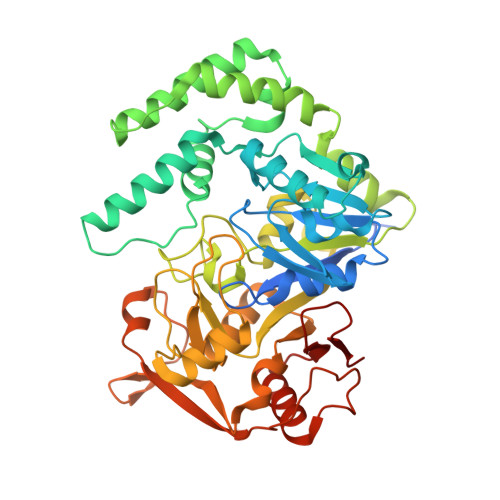Feedback inhibition and product complexes of recombinant mouse muscle adenylosuccinate synthetase.
Iancu, C.V., Borza, T., Fromm, H.J., Honzatko, R.B.(2002) J Biol Chem 277: 40536-40543
- PubMed: 12186864
- DOI: https://doi.org/10.1074/jbc.M204952200
- Primary Citation of Related Structures:
1MEZ, 1MF0, 1MF1 - PubMed Abstract:
Adenylosuccinate synthetase governs the committed step of AMP biosynthesis, the generation of 6-phosphoryl-IMP from GTP and IMP followed by the formation of adenylosuccinate from 6-phosphoryl-IMP and l-aspartate. The enzyme is subject to feedback inhibition by AMP and adenylosuccinate, but crystallographic complexes of the mouse muscle synthetase presented here infer mechanisms of inhibition that involve potentially synergistic ligand combinations. AMP alone adopts the productive binding mode of IMP and yet stabilizes the active site in a conformation that favors the binding of Mg(2+)-IMP to the GTP pocket. On the other hand, AMP, in the presence of GDP, orthophosphate, and Mg(2+), adopts the binding mode of adenylosuccinate. Depending on circumstances then, AMP behaves as an analogue of IMP or as an analogue of adenylosuccinate. The complex of adenylosuccinate.GDP.Mg(2+).sulfate, the first structure of an adenylosuccinate-bound synthetase, reveals significant geometric distortions and tight nonbonded contacts relevant to the proposed catalytic mechanism. Adenylosuccinate forms from 6-phosphoryl-IMP and l-aspartate by the movement of the purine ring into the alpha-amino group of l-aspartate.
Organizational Affiliation:
Department of Biochemistry, Biophysics, and Molecular Biology, Iowa State University, Ames, IA 50011, USA.


















